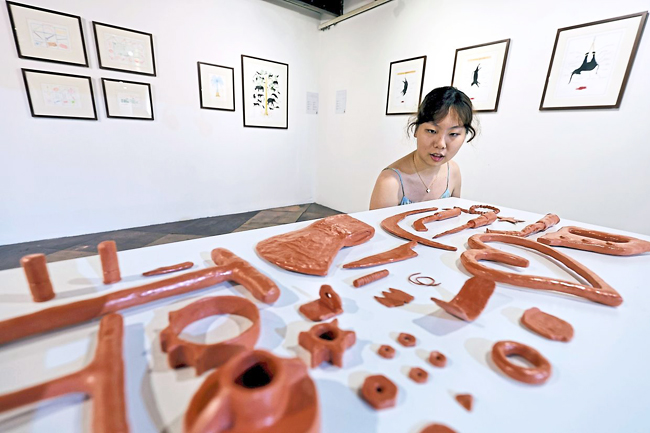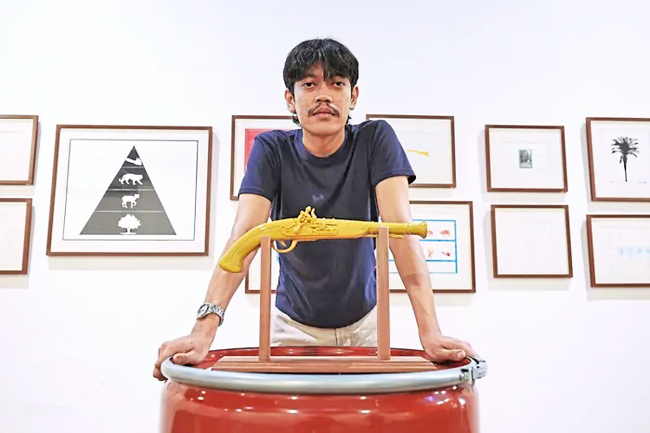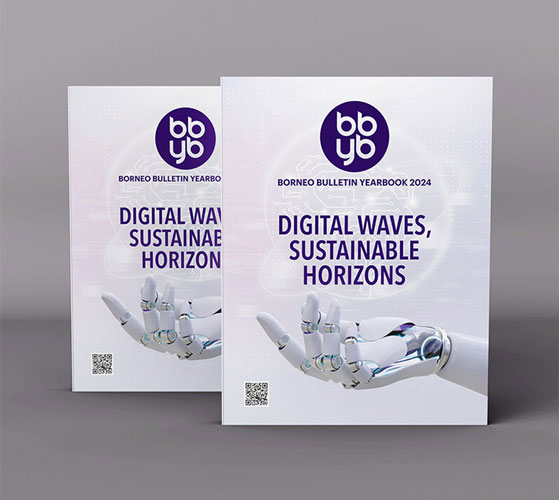ANN/THE STAR – Artist Anas Afandi, raised in Taiping, Perak – often called the “wettest town” in Peninsular Malaysia – fondly remembers the cool, unspoiled beauty of his hometown.
“Taiping’s abundant rainfall once nurtured lush flora and fauna, but recent visits show changes – less mist, higher temperatures and a shifting landscape,” said Anas, 33, whose debut solo exhibition ‘I Love God, Gold, & Glory’ is on display at Wei-Ling Gallery, Brickfields in Kuala Lumpur until October 19.
“You could say global warming inspired my work,” he added.
Anas’ artwork ‘Climate Crisis’ – a leaky, hole-riddled bucket labelled ‘Rain Catchment Taiping’ – greeted visitors at the gallery entrance.
In this show, he examined the colonial legacy’s lasting impact on Malaysia’s environment and cultural identity.
The exhibition title ‘I Love God, Gold, & Glory’ also nodded to the three main motives behind European colonisation during the Age of Discovery: gold, gospel and glory.
“Throughout this series, I viewed the natural world as its own institution, profoundly influencing our culture – our idioms, motifs in handicrafts and architecture, and dances, all inspired by nature,” said Anas, a Kuala Lumpur-based artist whose practice spans drawings, paintings, sculptures and installations.
“I consider what might happen if we keep damaging the environment. Without a shift in values and a true appreciation for nature, Malaysia risks losing its cultural uniqueness,” he added.
REMNANTS LEFT BEHIND
Anas pointed out that Malaysians are often shown Western images of melting glaciers and polar bears as symbols of climate change.
“But these are images that I cannot relate to. So this led me to wonder if I could attempt to portray environmental degradation from the perspective of a South-East Asian.
“As Malaysians, we tend to romanticise our connection with nature, but do we really walk the talk or is it a mere superficial ‘branding’ effort? That was one of the things I wanted to explore,” he said.
The exhibition featured 44 pieces created with acrylic, watercolour and coloured pencil, along with two installations. Much of it resembled museum displays or textbook diagrams, using a primary colour palette of red, blue and yellow to reflect the Malaysian flag, as Anas noted.
He revealed that he read many scientific papers during the two years he spent researching this series. “I’m particularly fascinated by archaeology and scientific methodology, so I think I subconsciously adopted that look and feel into my work,” he shared.
A DOSE OF SATIRE
Although many pieces address environmental issues, the series explores more than just that.
“That’s just one part of it. The more I looked into our relationship with the environment, the more I realised that it goes beyond that. As a result, a new question emerged: what is the role of the environment and how does it intersect and affect the construction of culture, identity, and nation?” he said.
Anas adopted a satirical perspective on colonial history and its influence on contemporary Malaysian society.
“Our colonial past is marked with a legacy of economic exploitation, environmental harm, and social disruption. So I used humour as a critical tool to highlight the nonsensical, absurd nature of the situation where destruction and conservation always seem to go hand in hand,” said Anas.
In one of his installations, a random collection of objects are laid out on a table as if they had been unearthed in an archaeological excavation taking place in the future. The make-believe “artefacts” consisted of tools used in oil palm cultivation, spare parts of a chainsaw, fragments of an axe and hunting knives and that all-too-familiar touristy heart sign that you’ll find in many towns and cities, to name a few.
“In this work, I am offering the audience an understanding of our actions and a glimpse of what our culture and nation will be known for in the future,” Anas concluded. – Hanis Maketab




